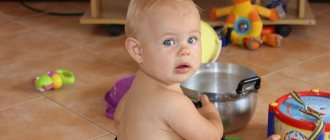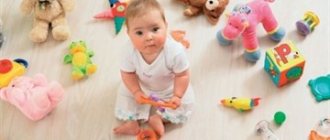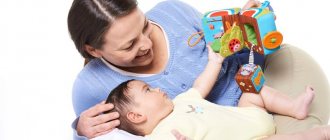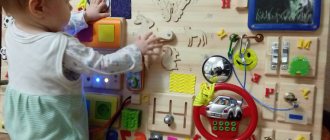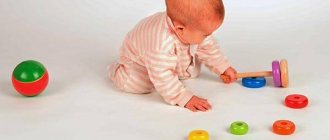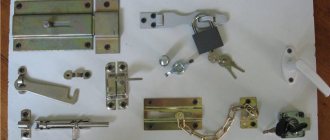Hello dear readers. Your little one is already 10 months old. Every day he explores the world more and more actively. The child is crawling around the apartment and now needs careful monitoring. The baby becomes curious, he definitely wants to try to repeat what his parents do. For proper overall development, it is important to know which toys to give preference to and how you can play with your little one. The issue of improving fine motor skills remains important. These are the topics we will talk about in this article.
Baby's height and weight at 10 months
The rate of increase in height and weight is slowly beginning to slow down. Weight gain is no longer taking place by leaps and bounds. Moreover, now the child is more active than ever and there is a large expenditure of energy, and, accordingly, calories.
Norms for a 10 month old child. A child's weight at 10 months is approximately 9.5 - 10.3 kg. Height 72 - 74 cm. Baby's head at 10 months (circumference) 45 - 46 cm.
Toys for a child 11-12 months old (advice from an experienced neurologist).
A couple of months ago they called a neurologist, among other things, she said what toys we should definitely have. I share useful information:
1. Yula. The doctor said that it should be on a wide base, because... A child at this age does not yet know how to twist an ordinary spinning top on a sharp base. But Nastyukha spins the regular one perfectly, plus we have two carousels on a suction cup, which she also really likes to spin - like this:
That's why I didn't buy it. Somehow it seems to me that such toys are no longer for our age; there are a lot of much more interesting things that we can spend money on.
2. Puppet theater. Our beloved Nyamlik:
was mercilessly criticized by the doctor. Like, the child sees nothing but a huge mouth. Despite this, we, of course, left Nyamlik, because... Nastyukha adores him, but they also bought a puppet theater called Masha and a bear with rubber faces. My daughter is delighted with them too.
3. Rolling stick. Not only one that the child follows on the street, but also one that can be rolled from a sitting position.
4. Whistle. We've had it for a long time. They learned to whistle, although at first they whistled into themselves, then they learned “out of themselves.”
5. There are two types of pyramids - rings and cups. We've both had them for a long time.
6. There are two types of cubes - large and small. We had big ones, but we bought more small ones.
7. Tent. We bought from Ikea, they had the most reasonable prices. We really like it.
I also liked this one in Sim^
It’s also inexpensive, with the org it costs about 900 rubles, but Ikea turned out to be faster, so I took it there.
8. Dry pool. We haven’t bought it yet and I can’t figure out where to put it in a standard two-room apartment. I think I’ll change it with a tent, just before I get tired of it. I’ll order the balloons in Sima - it’s the cheapest there.
9. Matryoshka. I never thought they were so difficult to buy. At least they are not available in children's stores. There are none at Wildberries. As a result, we bought it at a regular hardware store, having stumbled across it completely by accident. Very good for developing an understanding of size matching and for inserting and removing objects.
10. For a year old, the doctor advised me to buy a rubber donkey.
She also told me to let her eat 3-4 spoons during each feeding. We do this from the very beginning of complementary feeding and already know how to feed ourselves, with the most minimal help. And we didn’t know how to drink from a straw, because... I don't give juices. We learned very quickly.
www.BabyBlog.ru
Baby's diet at 10 months
What should I give my baby at 10 months? What does a 10 month old baby eat? The menu of a 10-month-old breastfed child is practically no different from the diet of a bottle-fed child.
A child's diet at 10 months already includes almost all the food from an adult table. The baby already eats vegetables and fruits, all cereals, different types of meat. The menu must include soup for a 10-month-old child and fermented milk products.
When introducing a new product to your child’s menu, pay attention to possible food allergies.
What toys should I buy for my baby?
- Your older baby still enjoys playing with rattles. It's too early to deprive him of his old toys.
- It is worth buying a plastic or wooden pyramid with multi-colored wheels of different sizes.
- The baby should have balls and other toys that can be used to provide him with physical activity.
- Plastic or wooden cubes of different colors can keep your child busy.
- You need to buy dolls made of soft materials - it can be rubber, fabric or soft plastic. Dolls should have clearly drawn eyes, nose, mouth, and ears so that the baby can study the human structure.
- Buy a toy piano or xylophone. Musical instruments develop motor-visual coordination in a baby and help strengthen cause-and-effect thinking: press a key and a certain sound is heard.
- Buy toy plastic plates and cups that are the right size for your baby (the diameter should be approximately equal to the size of his palm).
- Buy toys depicting various animals. They will contribute to the accumulation of knowledge about the appearance of fauna representatives.
- Technical toys will also be very interesting: these could be cars, a telephone, etc. If your child starts walking, buy him a toy stroller for dolls. Rolling a stroller with a doll is interesting for both girls and boys.
The above list of toys is needed in games that promote the proper development of a child from 10 months. Dad and mom should both take part in activities with the baby. They perform different role functions at home and do not replace each other for the child.
READ ALSO: What should a boy child be able to do at 10 months?
You definitely need to take a lot of walks with your child. There are so many interesting things to do outside for a little person! Show him a living bird, a cat, a dog, a flower - let the baby learn about the diversity of the world around us.
Make an effort to develop perseverance in your 10-month-old baby. He should be able to hold his attention on one object for at least 3 minutes - try to concentrate his attention on the same toy (we recommend reading: how does a child develop at 1 month and what should he be able to do?).
Baby's daily routine at 10 months
How long does a 10 month old baby sleep during the day? On average, this is approximately two daytime naps of 2 - 2.5 hours. But this is individual, depending on the activity and temperament of the child. Night sleep 10 – 11 hours. Which may also not correspond to your reality.
10 month old baby doesn't sleep at night? Does your 10 month old baby wake up frequently? A 10 month old baby wakes up and cries? In the article “How to develop a child at 8 months: what he can do and how to play,” you can find your reason for such problematic sleep.
You can introduce massage into your daily routine for your 10 month old baby. You can read about how to do it and its benefits in the article “What kind of massage can be given to a child.”
Putting things in order
Stock up on clean containers - a basin, a bucket, a plastic box. Show your child how to put balls, cubes, a pyramid in a basin, and put the toys in a bucket. Each toy makes a certain sound when falling, this will once again help the baby distinguish the toys from each other. Pour the toys back onto the floor or into the crib and ask your child to collect them.
INTERESTING: how to teach a child to assemble a pyramid correctly and quickly?
Play detective with your child. Put the ball in the bucket and ask him to find the ball, hide the toy under the pillow or cover it with a bowl. When your baby finds the hidden objects, praise him.
Ask the baby where dad is, where the woman is, where the aunt is - let him look with his eyes for the named people. Place the toys upside down in front of your child and see if he wants to turn them over correctly.
What a 10 month old baby can do development
A 10-month-old child moves a lot, remembers and analyzes a huge amount of information, learns to interact with people and objects, and tries to evaluate actions and the results of them.
What should a 10 month old baby do?
- The child crawls confidently and correctly on all fours in any direction. If this is not the case, then in the article “How to develop a child at 8 months: what he can do and how to play,” you can watch the educational video “How to teach a child to crawl.”
- Sits well on his bottom without support and at the same time plays freely with toys.
- Can stand on his own feet.
- Walks along a support, by an adult’s hand, or with the help of a special toy walker.
- Can bite off and survive pieces of hard food (apple, pear, dry food).
- At the request of an adult, he performs basic actions: stands a tower of cubes, assembles a pyramid of rings, leafs through a book, rolls a car.
- Knows how to interact with objects: pushes a ball from a pyramid with a stick, destroys a tower of cubes by throwing a ball into it.
- Climb onto heights: armchair, chair, sofa, step.
- Stands for some time without support or support from an adult.
- From a standing position he can sit on his butt.
- Opens and closes containers, drawers, cabinets.
- Understands and fulfills simple requests from an adult: find this, give this, throw the ball.
- Knows how to use a spoon and a mug. But this is not necessary at this age. For some, this will happen a couple of months later.
- Tries to imitate facial expressions, emotions and gestures of adults.
- Pronounces syllables.
You can already see which hand is the baby’s main “working” one. And if it’s the left one, then there’s no need to retrain it, it would be a mistake.
Showing your child new actions
Take a pyramid, show your baby how to take it apart on a wheel and then put it back together. Help him put the ring on the stick by guiding his pen to the correct position. Gradually teach your baby to wear rings depending on the size. It won't happen right away, but gradually you will achieve success. Show your child how to add blocks. Fold the cubes based on their colors, then scatter them in random order. Give your child the opportunity to repeat your actions.
Take white sheets of clean paper and crumple one of them into a ball. Give the second sheet of paper to your baby and help him crumple the paper. He will try to crumple the third sheet without your help. Throw the resulting “snowball” at the baby or at some distant object for accuracy. If your baby throws a snowball at you, dodge so that he understands how to play snowballs, then he will also start dodging your snowballs. If he pulls the paper into his mouth instead of crumpling it and rolling a snowball, put off the game for 1 - 2 months - it’s too early to entertain the child in this way.
Wear necklaces with large beads around your neck. Remove the beads and give them to the baby. Have him put them on, then help him take them off. Approximately the same procedure can be repeated with a bracelet made of large plates with an elastic band. Put the bracelet on the baby's arm, take it off, extend your hand to him - let him put the bracelet on you.
INTERESTING: how to make a development board with locks and buttons for a baby with your own hands?
You can offer your child other exercises to develop fine motor skills. Show him how to unscrew caps from empty plastic bottles. The child will try to repeat your actions, just make sure that he does not swallow the cork.
How to develop a child at 10 months
Initially, pay attention to the section above “What should a baby do at 10 months.” And if your baby has not yet mastered anything from this list, then first of all start teaching these skills. The child is not sitting for 10 months? This is an omission of parents that they must urgently correct. You may need to consult a pediatrician.
The baby is already ready to expand his horizons: go for walks in new areas, make new acquaintances, let the child play with peers. The child is already ready for contact and socialization.
It's time to teach your child to be independent: use a toothbrush, spoon, napkin, teach him to dress and put on shoes. It is clear that you will redo all this. But the fact that the baby must do this himself will definitely be imprinted in his head.
What to teach a 10 month old baby
- Develop and improve motor abilities: go to the pool, exercise on a fitball, do gymnastics, motivate your baby to constantly crawl, walk along a support, stand up and squat.
All active motor skills activities are more fun to do while listening to music.
- Explore the world around you: comment on everything to your baby, let’s touch, play, explore.
- Games to develop memory and logic.
- Games with small objects to develop fine motor skills.
- Develop your baby's speech ability.
A 10 month old child needs to be potty trained?! Experts strongly recommend not to do this now. This will be hassle-free for both you and the child. This activity is completely useless at this stage. Since the child does not yet know how to control his physiological processes. And there will be no point.
Educational games for a 10 month old baby
- The more “adult” the toy, the more interesting it is. That is, the child is now interested in playing with household objects: pots with lids, jars (not glass, of course), ladles, dad’s tools, mom’s combs and hairpins.
Parents' task: provide only safe items for play! Nothing breakable, glass or cutting.
- Give the task to collect a lot of parts into a container. For example, put buttons in a box.
Such games should only be played under the supervision of an adult.
Such a game prepares the child to understand order and how to establish it.
- When you go for a walk, let your child take with him objects that interest him: pebbles, sticks, leaves. And then at home, carefully study them together, examine them, discuss their shape, texture, weight, and purpose. It may seem to you that this is useless and unnecessary for your baby right now, but it broadens his horizons very well.
- Let your child participate in household chores. Allow to rub the rag on the table or floor, stir in the pan with a spoon. This teaches the child that there are a number of household chores, teaches him to help and share household chores.
- Give a bunch of socks and ask them to sort them into pairs. Perhaps nothing will come of this, but the baby will like this activity.
- Allow your child to tap the pan with a spoon to the beat of the music. It's certainly a loud activity, but a lot of fun. And helps develop a sense of rhythm. What if you have an unsurpassed musician growing up?
- When you go to bathe your child, take a doll with you. Let the child wash the doll. In this game, the baby learns body parts and develops his motor skills.
- Start playing role-playing games. You can read how and why to play them in my article “Role-playing games for preschool children: why and how to play.”
- Snowball game". The child crumples the paper and tries to hit the adult. Here motor skills and accuracy develop, and it’s just fun.
By the way, allow your child to talk to his family on the phone. The baby tries his best to imitate adults. And this opportunity to talk like an adult contributes to the development of speech.
What toys do you need for a 10 month old baby?
Toys must be useful so that they can be rolled, disassembled, listened to, and so on.
- cubes
- pyramids
- nesting dolls
- large designers
- light balls of different diameters
- cards with large images of animals, vegetables, fruits, cars
- books with thick pages
- dough or plasticine
- sets of large beads and rope
How to convert games with old toys?
Dr. Komarovsky drew attention to the fact that at 10 - 11 months the baby, manipulating 2 objects at once, tries to do something with one through the other (we recommend reading: everything about the development of a child at 11 months). He knocks on the pan with a strainer, puts a ball in a bucket, that is, he uses one of the objects as a means of playing with another. The baby carefully watches the adults and tries to repeat their actions. He already understands who is in what mood - be cheerful and friendly with him. The more you show him in his presence which items are used how, the better. These actions can be performed in games.
A few weeks ago, your baby played with all the toys in the same way - he tasted them, hit them on furniture and on the floor, looked at them, shook them. It's time to use the toys for their intended purpose.
- Show your child how the phone works. Take a toy phone or a broken old phone, press a few buttons, pick up the phone and say, “Hi, I'm Mom.” Soon the child will understand that he needs to pick up the phone and call his mother.
- Take one car for yourself and another for your baby. Roll the car on the floor while saying “doo-doo” or “beep-beep.” The child will begin to repeat after you. Take a toy truck, put a small doll or teddy bear in it, roll it around the room with a string - the baby will also master this use of this toy.
- Ring the bell so that the baby listens to the melody, even from an earlier age. The time has come to give the bell to your son (daughter); let your child ring it on his own. Think of something pleasant that will happen after the bell rings - for example, patting the baby on the head - this will promote understanding of cause and effect relationships.
- Fun with a ball looks like this: you can roll the ball, like a car, towards the baby’s legs and back, you can throw the ball or roll it in different directions - towards a closet or buffet, stimulating the child’s desire to move along a certain trajectory. With this pastime you will provide your baby with physical activity.
Additionally, you can include in the “program” attempts to distinguish colors and shapes - this can be done using the most ordinary objects that you have in the house. A similar lesson is presented in the video.
Story games
At ten months, it’s time to teach your baby story-based games, which are simply necessary for full development, as they introduce him to basic life situations, emotions and rules of behavior. While playing, a little man not only learns about the world around him - he prepares for life in society, learns the laws of human existence. It’s worth starting with the simplest plots: show how the doll walks, eats, goes to bed, cries, how to roll a car or work with a toy hammer. Then complicate the story by giving your child a specific task.
- The doll walked, fell and cried. Have pity on her.
- The bear was dancing, very tired and wanted to sleep. Put him to bed.
- The bear and the bunny came to visit. Treat them to tea.
- The bunny went for a ride in his car and took his doll with him. Give them a ride.
- The bear came, said hello, sang a song and left. Say hello and goodbye to him.
- The chair broke. Help me fix it.
It is very useful to act out with your children situations that you have observed together in real life. For example, load bricks and cubes onto a car and take them to a construction site, or treat a doll by giving it medicine and warm tea. New toys will help make classes bright and closer to reality: dolls, cars, sets of dishes, construction and medical tools, doll furniture.
Educational games for children. How to help your child grow up cheerful and happy
The baby experiences special pleasure from moving in space - crawling or walking. He likes the process itself, although the process is not without certain difficulties and troubles; the child may get tired, fall and hurt himself.
Therefore, the baby perceives with particular pleasure such educational games in which crawling, or walking, or some important elements of these actions are reproduced in a lighter and safer, but accelerated or intensified form.
- Place a towel or folded blanket under the belly of the child lying on the carpet. Lift him up so that he is in a crawling position and rock him back and forth a little. Hold him so that he can crawl easily, and from time to time lift him into the air and carry him forward a short distance.
- The main ability that a child must develop when learning to walk is the ability to maintain balance. You can help him with this. Place your baby on your lap, spread his arms to the sides and hold them. Alternately raise one or the other knee, so that the child leans first to the right, then to the left. Help your child maintain balance by holding his hands. Raise and lower your knees to the beat of the music. You can put on a record, or turn on a tape recorder, or sing yourself, the main thing is that the music is cheerful.
- Place the child in front of you, facing you, and take his hands. Begin to slightly tilt it to the right, then to the left, moving its center of gravity from one leg to the other. Sing a song so that the child sways to the rhythm of the song. Keep your child's arms at shoulder level or even lower. Gradually reduce your support so that your baby continues to rock on his own. Let him then hold only your index fingers with his hands. Make his arms drop down and be positioned almost vertically on his sides. Try swaying to the rhythm of the song yourself. This will stimulate the child - he will try to imitate you.
- Place your baby's feet on your legs with his back to you.
Hold him by the shoulders. Say, “Come on, let's go,” and walk a short distance. Look how he reacts to this game. If he likes it, repeat it on different days. Let other family members, including older children, do this for you. Such a game helps strengthen contact between a child and an adult and is useful from this point of view. If the baby does not express pleasure in the game, put it aside and try again after some time. - Teach your child to “sing” to the music. Turn on the tape recorder, or player, or radio. Sing yourself, using those syllables (“mama” or “dada”) that the child can easily pronounce. Invite him to join you. Repeat this game many times until he begins to sing to the music on his own.
- Continue playing “Peek-a-boo, where am I?” with your child. First, cover the child’s eyes with your hands and exclaim: “Where is Misha, where did he go?” Having removed his hands, rejoice: “Misha is here!” Then teach the child to cover his eyes with his hands and wait for your exclamations: “Where has Misha disappeared?” Express delight when he removes his hands from his face. You can also teach him to cover his face with a napkin or diaper, and then pull it off. Your joy when the napkin is pulled off or the hands are removed from the eyes will contribute to the emotional development of the child.
- At this age, the child begins to understand how to attract or maintain the attention of an adult - and begins to repeat actions that made others laugh. You can support and develop this behavior in him by participating in a variety of games with him. For example, play with your child “A horned goat is coming for the little guys, gores, gores, gores, gores,” where first you portray this goat, and then he. Be scared when the child reaches out his hand in your direction, and then start laughing.
Games that develop speech
In the first year of life, the foundation of speech activity is laid. A ten-month-old toddler shows great interest in the person speaking, closely examining his lips and even touching them with his hands. This is how he studies the functioning of the articulatory apparatus, developing the ability to imitate speech. The baby can already repeat the simplest words, similar to babbling: mom, aw-aw, baba, dad, ha-ha, lalya. More complex consonants appear in his sound practice: “t”, “d”, “n”, “l”. The baby understands the meaning of many words and subtly feels emotions and intonations. While playing, the child must replenish his vocabulary, practice the pronunciation of familiar sounds and master new ones.
- "Talk". Say the syllable you want to train with a questioning intonation: “Ba?”, as if inviting the child to talk. In response, repeat the same syllable in the affirmative: “Ba - ba - ba” until the baby starts a conversation with you.
- "Learning parts of the body." The purpose of this game is to teach the baby to show the called body parts. Ask your child: “Where is Antoshi’s nose?” Take the child’s finger in your hand and touch it to the child’s nose: “Here it is, the nose.” The game should be repeated until the baby himself shows one or another part of his body.
- "Give - give - give." Place any objects in front of the baby, for example, food: cookies, apples, bread. Ask: “Sasha, give me some bread, please.” If the child cannot find his way, take the bread with his hand. Ask for items one at a time until your baby remembers their names.
- “Learning the names of actions.” While playing, ask your baby to perform familiar manipulations: take, give, put, show, throw, roll. If the child does not respond to the request, explain it with a gesture, or perform the desired action yourself.
At this age, children are already able to engage in word creation - to come up with their own short words to denote objects, actions and emotions.
